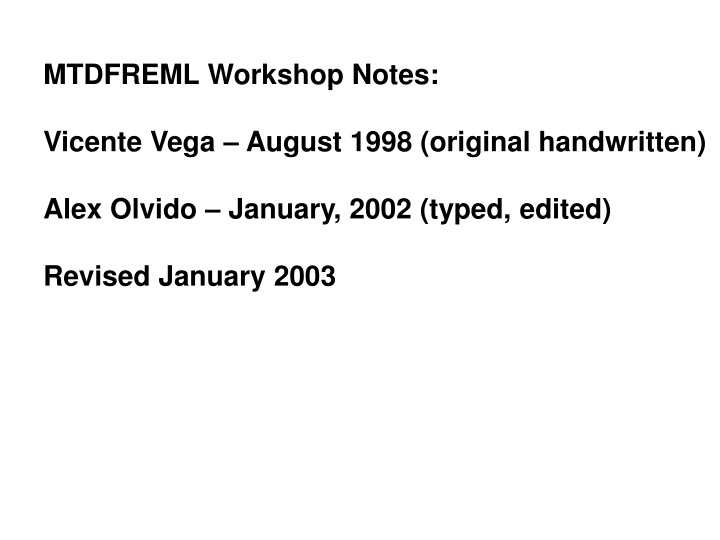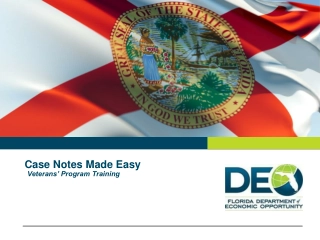
Derivative-Free REML Methods in MTDFREML Workshop Notes
Explore the concept of Derivative-Free REML in the context of MTDFREML Workshop Notes, discussing its significance, algorithms, and advantages over traditional methods like Expectation Maximization. Discover how this approach maximizes likelihood without using derivatives, simplifying the estimation process significantly.
Download Presentation

Please find below an Image/Link to download the presentation.
The content on the website is provided AS IS for your information and personal use only. It may not be sold, licensed, or shared on other websites without obtaining consent from the author. If you encounter any issues during the download, it is possible that the publisher has removed the file from their server.
You are allowed to download the files provided on this website for personal or commercial use, subject to the condition that they are used lawfully. All files are the property of their respective owners.
The content on the website is provided AS IS for your information and personal use only. It may not be sold, licensed, or shared on other websites without obtaining consent from the author.
E N D
Presentation Transcript
MTDFREML Workshop Notes: Vicente Vega August 1998 (original handwritten) Alex Olvido January, 2002 (typed, edited) Revised January 2003
1. A little log-likelihood (logL) and mixed model equations (MME) 2. Programs, data, answer files 3. Convergence 4. Models 5. Compiling and recompiling Param.dat 6. Example of MTDFREML Keith Boldman Lisa Kriese Curt Van Tassell Steve Kachman Joerg Dodenhoff
MTDFREML Package: Estimate variances and covariances Predicts breeding values and SE of the predictions Estimates fixed effects and SE Find expected values of solutions Handle messy, unbalanced data (main advantage over least-squares methods) Analyze more than one trait (not same model for all traits) Good for GxE analysis (2 sexes)
Theory: Derivative-free REML REML = Restricted (or residual) Maximum Likelihood Likelihood divided in two parts: (1) fixed effects, e.g. age and sex, and (2) random effects, i.e. variances and covariances. Unlike random effects, the likelihood part for fixed effects is not maximized. Hence, likelihood function cannot be used with LRT for fixed effects. Would need to do ML or hold VC constant. At convergence for VC, can do t-tests, F-tests.
Goal is to find variance-covariance estimates that maximize the likelihood, given the data. It is easier, instead, to maximize the log of the likelihood, or logL. In practice, however, we minimize the quantity 2logL; we multiplied by 2 to get rid of the - of the likelihood function (see Boldman et al. 1995, p. 54). -2logL = F value Simplex algorithm looks for a minimum ==> method is a minimizer
REML is REML Usual REML methods are iterative: REML is itself not a method, but a goal. The goal is to maximize the likelihood any way you can. Hence, many algorithms for REML: (1) Expectation maximization (EM) ==> sum of squares (S.S.) and E(S.S.) - 1st derivative - never outside parameter space (2) Derivative-free (DF) (3) Newton-Raphson; Hessian, Fisher scoring - 1st and 2nd derivatives (4) Average information (AI) Except for DF, all of these methods need the inverse of the coefficient matrix (C-1). This requirement imposes a limit on what the program can do because required amount of time (T) scales to the cube of the number of elements (N) in C-1: T = N3 Unlike other REML methods, derivative-free REML doesn t need or use derivatives (hence, the name)
Instead, does something like a grid search (e.g. DF-REML) to find a maximum value for the likelihood function: Search for maximum, or peak 2 G 2E Unfortunately, this grid search strategy is not very efficient/powerful.
On the other hand, simplex algorithm (Nelder and Mead, 1965; see Boldman et al. [1995, Ch. 7]) makes DFREML more efficient: - no derivatives - no sum of squares (S.S.) - no expected values of the sum of squares, E(S.S.) - does not need inverse of the coefficient matrix Simplex algorithm relies on a useful form of 2logL
General mixed model (MM): Y = X + Zu +e , where Y is vector of (animal) records, X is association matrix for fixed effects, is vector of fixed effects, Z is association matrix for random effects, u is vector of random effects (e.g. genetic values), and e is vector of residuals, or unexplained variance. 1st moment ==> Expected value of Y, or E(Y), equals X 2nd moments ==> Variance of u , or Var(u), equals G Variance of e , or Var(e), equals R
In a very simple animal model, 2 G = A ==> Ais the relationship matrix for individuals in your dataset G 2E R = I ==> Iis an identity matrix, i.e. 1 0 0 0 0 1 0 0 0 0 1 0 0 0 0 1
Hendersons MME (almost completely general; see Boldman et al. [1995, Ch. 4]): estimates fixed effects 1 1 1 X ' R X X ' R Z X ' R Y = 1 1 1 + 1 ' Z R X ' Z R Z G ' Z R Y u predicts random effects coefficient matrix, solution vector, r,or vector of right-hand sides
Harville (1977) and Searle (1979): ==> results -2log(L|Y) = some constant + log|R| + log|G| + log|C| + Y PY Coef. matrix read as log of the determinant of the R matrix residual sum of squares = (Y R-1Y - s r) likelihood,L, given the data, Y; often presented simply as 2logL; but it is important to remember that likelihood estimates are only as good as your data ( garbage in, garbage out ) i.e. everything is a function of the MME Search to find R and G that minimizes 2logL C changes when you change R and/or G; X, Y, and Z stay the same (Recall that Y is vector of animal records, and X and Z are association matrices for fixed and random effects, respectively.)
In our simple animal model, we can find log determinants for R and G: 2 E 0 0 0 1 0 0 0 2 E 0 0 0 0 1 0 0 2 E 2E For log|R|: let R = I so that log|I | = log 2 E 0 0 0 0 0 1 0 2 2 = log( )n = nlog( ) E 2 E E 2 E 0 0 0 0 0 0 1 where n is simply the number of elements (or number of records) along the diagonal of the R matrix. 2 G And for log|G|: letG = A so that log|A | = log|AI | = log|A| + log|I | = log|A| + qlog( ) where q is the order of the numerator relationship matrix, A (Boldman et al. 1995, p. 56). Note that log|A| is a constant because A is the (predefined) numerator relationship matrix and could be ignored. 2 G 2 G 2 G 2 G
Of course, the coefficient matrix, C, for the MME (see Hendersons MME, above), changes with different combinations of R and G. Note that to calculate log|C|, C has to be full rank, meaning that the dimensions of C equals the number of linearly independent rows and columns in that matrix, thus resulting in a non-zero determinant (Mrode 1996, p. 161). Because C is usually not of full rank, a constrained C (i.e. C*) is used. Lastly, the generalized residual sum of squares, Y PY, in the simplest case is ( / 1 y2 i ) s' r 2e
A brief history of MTDFREML (see also Boldman et al. [1995, pp. 55-58]) 1. Smith and Graser (1986, J. Dairy Sci.) = idea for a derivative-free system = use Gaussian elimination to find solutions for log|C| and Y PY (in Harville-Searle MME, above) = in Gaussian elimination, you go from this ==> C r r Y R-1Y to this ... ==>Y PY = Y R-1Y s r ... by eliminating one equation at a time. = At the end of Gaussian elimination, you get the determinants that you need.
2. Graser et al. (1987, J. Anim. Sci.) 3. Meyer (1988, 1989, 1991) = developed DFREML, the first program to carry out Gaussian elimination, but very slowly = a short time later, Keith Boldman messed around with subroutines contained in SPARSPAK and got 100-600X the speed of Meyer s original DFREML program
The basic strategy behind Smith and Grasers DFREML (and, thus, Meyer s DFREML programs) is to try out different combinations of R0 and G0 until you get the minimum value for 2logL. In the simplest case, let G0 = and R0 = . For the simple example, 2 G 2E )X ( 2e 1 = X' R X X' I 1/ The coefficient matrix, C, would be ) ) ( ( 2e 2e X' I 1/ X X' I 1/ X ( ) ) ( 2e 2e 2g 1 + Z' I 1/ X Z' I(1/ ) A 1/ And the vector of right-hand sides, r, would be ) ( 2e X' I 1/ Y ) Y ( 2e Z' I 1/
In practice, MTDFREML uses the simplex algorithm as a search strategy ADVANTAGES of MTDFREML: 1. relatively simple procedure 2. does not need sum of squares (S.S.) 3. does not need analysis of variance (ANOVA) 4. can use sparse matrix (i.e. non-zero elements of coefficient matrix) techniques; which is important for practical reasons: Suppose we have 1000 MME Then, # of coefficients = (1000 MME)2 = 1,000,000 coefficients (in our square C matrix) Each coefficient takes up 8 bytes (double precision) of computer memory ==> 8,000,000 bytes = 8 megabytes (8 Mb) required computer memory
DISADVANTAGES of MTDFREML: 1. too easy; hence, no compelling need to find a better way 2. analyses with >2 traits take too long to reach convergence point = time to converge (Misztal) goes up by the 5th power of the # of traits, i.e. (# of traits)5 3. doesn t give standard errors (SE) of variance-component point estimates 4. doesn t always give SE for h2 and rg estimates, especially in multiple-trait analyses 5. computations are just black boxes a. simplex algorithm b. SPARSPAK ** **
About the (downhill) simplex algorithm (Nelder and Mead [1965]) = also known as the polytope method [Boldman et al. 1995, Ch. 7]) and amoeba 1 routine = Numerical Recipes to search for minimum value of 2logL Vector of parameters = e.g. in a model with maternal effect variances: direct (animal) genetic var. (A) 2 A 2 M indirect (maternal) genetic var. (M) R, G, C, Y PY matrices change -2logL changes covariance between A & M AM 2 PE 2 E maternal permanent environ. var., PE residual (error) var., E parameter vector 1A type of microscopic, one-celled organism that continually changes its shape during locomotion and food acquisition.
The simplex algorithm... 1. changes the values of the elements in the parameter vector according to certain rules 2. keeps parameters within parameter space, e.g. AM < ( ) 3. saves (p+1) sets of parameters (i.e. those in the parameter vector) and the value of -2logL in each run 4. always saves a set of (p+1) parameters including the best, where p is number of parameters (5 in the above maternal effects model) 2 A 2M Variance of the simplex, Var(-2logL), is used as the stopping criterion When Var(-2logL) is small ==> convergence What is small? Typically, start with 1x10-6 as the initial convergence criterion; later, use 1x10-9
Local maximum versus global maximum: A mountain peak analogy local 2; re-start local 1; re-start ** global ** big jump big jump As the simplex moves towards a peak, successive steps get smaller. This is a problem if the peak is local, since our goal is to reach a global peak. Hence, we re-start the amoeba routine once the simplex has stopped at a local peak in order to make the simplex take big jumps that move it away from that local peak and (hopefully) towards the global peak there is, by definition, only one global peak.
At start of each MTDFREML run, everything moves 1.2X (or 20% greater than) each element in the parameter vector: 1.2X 2 A 2 M Then calculate 2logL 1.2X Again, calculate 2logL AM 1.2X Again, calculate 2logL 2 PE 1.2X Again, calculate 2logL 2 E 1.2X Again, calculate 2logL Start amoeba routine
SPARSPAK = originally licensed by University of Waterloo; the version now used was purchased by USDA and is now license-free for MTDFREML = stores sparse (non-zero) coefficients, i.e. the coefficient matrix, C, for the MME = reorders the MME to speed up calculations, and remembers the reordering = based on Choleski factorization (see Boldman et al. [1995, pp. 59-61]) 0 0 11 L = = 0 21 22 31 32 33 C = LL' 11 13 12 L' = 0 22 23 0 0 33 Kachman modified Sparspak to skip and remember rows of L with zero diagonals (dependencies)
= from Choleski factorization, can get log|C| very easily... log|C| = 2log|LL | = log|L| + log|L | = 2 log(lii) = ...and s from r andL LL s = r let u = L s; thus, Lu = r ==> down-solve for u and L s = u ==> up-solve for s = ...which provides complete solutions to MME of the form Cs = r = factorization (LL ) is slow; but once L is found, this gives basis for finding (1) SE of fixed effects ==> fast (2) SEP of random effects ==> fast (3) expectation of solutions ==> slow, because need to multiply by C
Implementation of MTDFREML: 3 programs (coded in Fortran77) (1) MTDFNRM.FOR = numerator relationship (=genetic association) matrix, A = calculates elements of A-1 from a list of animals, sires, and dams via Henderson-Quaas rules = needs a pedigree list
(2) MTDFPREP.FOR = data-preparation program = takes history file and converts it to a useful, more condensed file = re-orders levels of factors to equation numbers = handles missing traits in the R-1 matrix
(3) MTDFRUN.FOR = major computing program for the simplex; uses several other subroutines: a. MTDFLIK.FOR ==> subroutine to calculate the log-likelihood and other things b. SPARSPAK.FOR ==> subroutine for sparse storage, reordering, solves c. MTDFSUB.FOR ==> subroutines, e.g. to calculate eigenvalues and generalized inverse d. MSTIME.FOR ==> timer subroutine
All three programs expect pedigree information (but can be unknown for all animals) Henderson-Quaas (A-1) rules: (1) Animal-sire-dam model Sire (can be 0) Animal Dam (can be 0) (2) Animal-sire-maternal grandsire (MGS) Sire Animal MGS of animal Dam (3) No relationship (A-1 = I) set up your pedigree this way ==> Animal Sire Dam 0 69xxx 0 (4) Not animal model 1 0 0
MTDFREML handles two types of data fields: (1) fields of integers, containing only integers = integers in free (= ASCII) format (space or comma between the fields) = no decimals, no alpha-numeric = integer must be less than 231-1 (size of 4 byte integer) (2) fields of reals, which can accomodate both integers and decimals = traits and covariates = missing trait value indicator ==> 0 or -9 = no missing value indicator for covariates (must check data and discard?)
MTDFNRM, the first program in MTDFREML: accepts only integer fields not all fields need to be used (i.e. animal, sire, and dam ID numbers); MTDFPREP,the next MTDFREML program, handles "reals" and integers; all integers first, then reals (which can contain integers); not all fields need to be used.
A closer look at MTDFNRM = converts original animal ID s to sequential ID s, e.g. 69xxx --> 1, 69xxx --> 2, etc. = requires that parental ID numbers be less than animal (i.e. progeny) ID numbers = produces output in several files: (1) MTDF56 (ASCII file) ==> log file; shows no. of animals (unique ID numbers) (2) MTDF44 (binary file) ==> elements of A-1 (not summed); used in MTDFRUN MTDFPREPprogram (3) MTDF11 (ASCII file) ==> matches original and reordered ID s; used in program (4) MTDF13 (ASCII file) ==> outputs inbreeding coefficients for animals, sires, and dams; optional recoded ID original ID F* animal sire dam animal sire dam animal sire dam * merge with your data set to include inbreeding in the analysis;
= also, with Westell groups: for crossbreeding experiments, put in ==> animal sire breed dam breed keeps track of fraction by breed --> ** ** = input file could be a separate pedigree file or the actual data file. = If using separate pedigree and data files, important that the ID numbers in both files are same; okay to have extra animals in the pedigree file How MTDFNRM works: Pass 1: stores all unique ID numbers; if animal (or sire or dam) ID repeated, stores only one set, sorts all unique ID numbers into an ordered vector of ID s Pass 2: recodes animal, sire, and dam ID stores all ID numbers into 3 separate vectors then calculates A-1 elements and F; amount of time = (number of animals)2
MTDFPREP in a nutshell = prepares data and formulates model from history file = reorders levels with 1, 2, 3,... to assign equation numbers = matches animal original ID to recoded ID, e.g. 1, 2, 3,... = deviates the observations and covariates from the raw trait means to reduce rounding errors in the computations = two kinds of input files: (1) MTDF11 file from MTDFNRM (2) data file
Output files: (1) MTDF66 (ASCII file) ==> summary (or log) file; gives equation numbers (2) MTDF50 (ASCII file) ==> set up equation numbers; used in MTDFRUN (3) MTDF51 (binary file) ==> recoded data files; used in MTDFRUN (4) MTDF52 (binary file) ==> recoded data files; used in MTDFRUN (5) MTDF21 (ASCII file) ==> allows matching solutions with original levels of fixed effects; used in MTDFRUN (6) MTDF22 (ASCII file) ==> optional; for matching original codes with solutions for uncorrelated effects; used in MTDFRUN
HINTS for MTDFPREP: = MTDFPREP does not handle zero levels for fixed factors. = we want sparseness; so if you can combine (fixed) factors, e.g. subclass H-Y-S-A, herd, year, sex, age of dam, etc., then do so beforehand; this way, you will maximize efficiency by creating a diagonal and sparse (C) matrix. = also, don t use too many regression coefficients; sometimes better to break up the effect into separate classes. Free format: all integers, then all reals; not all need to be used.
How MTDFPREP works: Pass 1:reads, then stores, levels for all factors sorts levels from low to high Pass 2:recodes levels calculates deviations of observations and covariates from means to reduce rounding errors matches and recodes animal ID from MTDFNRM
MTDFRUN: This is where the heavy-duty number-crunching takes place User inputs starting values Input from MTDF50, MTDF51, MTDF52, MTDF11, MTDF44 Calls SPARSPAK; creates MME; reordered and remembered LIK subroutine MTDFRUN pgm MTDF58 Calls SPARSPAK; forms MME; Cholesky factor Check validity of log|R| & log|G| (after update) LIK subroutine MTDFRUN pgm Input from MTDF50, MTDF51, MTDF52, MTDF11, MTDF44 NO Convergenc e? Update R0, G0 amoeba routine -2logL YES Output MTDF76, MTDF4, MTDF54, and others (all ASCII files)
** VERY IMPORTANT** = once you ve reached initial convergence, re-start MTDFRUN with new solutions stored in MTDF4 (first, rename MTDF4 to MTDF4.1; later, you can use a DOS batch program to re-run MTDFRUN) e.g., MTDFRUN<MTDF4.1 = compare values of 2logL from adjacent runs (-2logL = FVALUE); if no difference between current and previous run, then assume convergence at global maximum = D.V.V. rule-of-thumb: (1) same 2logL value at 2nd decimal place AND (2) h2 and rG not changed at 2nd decimal place ==> probably reached global maximum
The CONTINUE option in MTDFRUN = as if did not stop previous run = uses MTDF54 (simplex takes smaller and smaller steps towards local or global maximum) = also can be used for calculating SE, contrasts, PEV, or expected values, after convergence = use continue (not start ) option, i.e. OPTION 4, to automatically read MTDF54 file; then MTDFRUN will go to contrasts, etc; if run other program in between, then enter G and R priors by hand
Entering starting values in MTDFRUN = program prompts you to enter priors, depending on which model you want to run (1) In model with 2 traits and maternal genetic component ==> 10 inputs: a1 a2 m1 m2 a1 1 a2 2 5 m1 3 6 8 m2 4 7 9 10 (2) In model with 2 traits only ==> 3 inputs: a1 a2 a1 1 a2 2 3
(3) In model with 1 trait and maternal genetic component ==> 3 inputs: a1 m1 a1 1 m1 2 3 = cannot use 0 in variance position (numbers along the diagonal); = zero okay in covariance (off-diagonal position), if zero in off-diagonal, will be constrained to zero. = if re-entering incorrect values, just need to re-enter the ones that you want to correct)
= other uncorrelated random effects: T = Trait C = Field in data field (dam) T1C3 T2C3 T1C3 1 T2C3 2 3 T1C3 1 T2C3 2 T1C4 3 T1C3 T2C3 T1C4 4 5 6 = covariances should be zero for row-column intersections with different field numbers (e.g. entries 3 and 5 in table above)
= convergence criterion ==> Var(-logL) = enter 1.D-6; works most of the time = number of simplex rounds = D.V.V. rule ==> enter "1" for the first run in order to get an idea of the program runtime = when restart ==> about 2 likelihoods evaluated per round = how many simplex rounds to reach convergence will depend on number of traits you analyze at once 2E 2 G = for and in single trait analysis ==> 30-40 rounds (maybe) = for two-trait analyses with and AM ==> maybe something between 200 and 500 rounds 2M !! Some times stops with all values in simplex the same (so cannot move) usually restart breaks that up
= starting values must be reasonable, e.g. phenotypic variance 2X as big as real value is unreasonable = find reasonable variance by using MTDF66 output: 2Y Raw total phenotypic variance, = (SD)2 The real one will be smaller; therefore, try 0.6*(SD)2 For MTDFRUN input, force total of variances to be ~0.6*(SD)2
= Find reasonable covariance from phenotypic SDs: in theory, G , 1 G 2 = + 1 r 1 G , 1 G 2 G 1 G 2 so that G , 1 G 2 G 1 G 2 therefore, guess sign and (fractional) magnitude of rG, e.g. 20% of Y1,Y2, or 0.2*(SDY1 SDY2) = also, try checking for G0 eigenvalues If negative eigenvalues, then stops program ==> Starting values out of bounds
Models = fixed factors subclasses = covariates (linear, quadratic, and/or cubic) covariates are deviations from means if difficultyin interpretation remove line in MTDFPREP.FOR and recompile? = covariates into classes = random effects (= factors)
Animal models (1) Animal genetic only (simplest): genetic random effects = make sure A not equal to I a + e 2PE (2) Dairy example (I and I uncorrelated): a + pe + te repeated lactations) 2 TE 2 G 2 TE 2PE
(3) Beef example: ai + mj + pej + tei genetic components, , A 2 2M , AM = must have a dam ID; if not known, then assign a unique ID to each unknown dam = genetic covariance includes a covariance between ai and mi, i.e. AM (4) Swine example: + litter + tei mj + pej ai sow animals born at the same time
Sire models (1) Sire only model = okay if A equals I = could use A for all animals = could use A from males only (2) Sire and dam model = sire as 1st genetic effect (a), dam as 2nd genetic (m), and maternal permanent environmental effect (pe) = alternatively, sire as genetic effect (a), and dam as uncorrelated random effect (m+pe) (3) Sire and grand-maternal sire (MGS) model = sire as 1st genetic, MGS as 2nd genetic, and dam (within MGS) as uncorrelated random effect = could use A via males (sire-MGS rules)






















